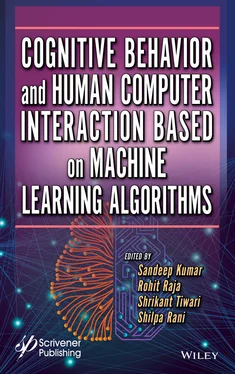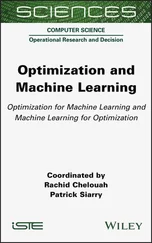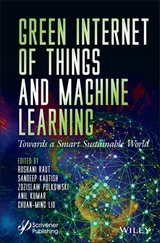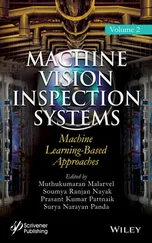Supporting cognitive model (Figure 1.4) for interaction of decision supportive architecture is embodied with the following three necessary steps.
The initial step to provide the model with supporting decision-making capabilities for perception and action among human-computer interaction with the task simulation is to extend the necessary cognitive tools as architecture to become a complete model by adding an eye with a simulated hand.
In the second step of the cognitive model to the simulation, the simulated eye and hand observations are to be recorded, and that information is to pass into the cognitive model for necessary actions.
The model’s final step is categorized into two specific parts as simulated eye and hand implemented in that environment as the simulation by using necessary simulation tools, whereas the cognitive model can be separated. Here, there occurs a communication mechanism between two such separated specific parts as in the form of interaction done simulated eye and hand with cognitive modeling [16].
1.3.3 Representational Uses of Cognitive Modeling for Decision Support User Interactive Device Systems
Some of the representations in cognitive modeling topics are described with descriptions in the following diagram [17].
Table 1.2Representational uses of cognitive modeling for decision support user interactive device systems [17].
| Topic |
Representational expectations |
Comments |
Model understand the context  |
Objectives in the form of sentential statements, to verify the relationship, data discovery, and investigation of data. To high-level requirements for visualization model or architecture. The dominant type of visualization is based on data analysis and exploration. |
The ambiguity possible with sentential representations can be an advantage without ambiguity. |
Model structure definition 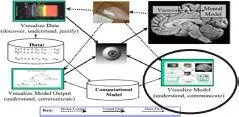 |
The relationship provided in model supportability through data analysis, visualization of the model, decomposition of the problem, and variable specifications. The dominant type of visualization model may be computed probably with the help of given fullest resources utilization. |
The activity usually received total resources what we thought was the significant portion. Visual tools range from “Balloons and Strings representation of relatedness” to tables of storage format, spreadsheets, and visual framework of activities. |
Realization of the model 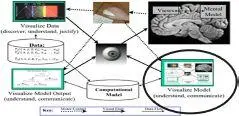 |
Identification of solution with the help of a more concrete model as adequate parameter estimation. The dominant visualization type is to be built by continuing the suitable model at various levels of hierarchy. |
Supports for the hierarchical problem decomposition into chunks at various levels visualization. |
Assessment of the model 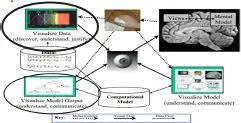 |
Provided correctness, feasibility, and acceptability in validation of the model. |
The stakeholder target is justified through context given by the right modeler with colleagues, customers, and users. |
Implementation of the model  |
The suitable model is implemented and managed its transmission into active usage. |
Completeness of visualization to assist marketing and training. Good speed and benefits concerning turnover in personals the number of new users of the model. |
Understand model context
Define structural model
Realization of the model
Assessment of the model
Model implementation
1.4 Cognitive Modeling: Management Information User Interactive Device System (MIUIDS)
Today, all industry stakeholders consider the different interfaces since it provides feedback on a new product’s effectiveness in real life. However, one must not forget the adoption of interface communication from character user interface data to voice user interface information. The information is a key to the process and storage of any organization. The stakeholder, mainly customer experience, is immediate valuable feedback and product safety and low maintenance are complemented strategically designed with the necessary management user interactive device system. The essential elements of the management user interactive device system are described with the necessary diagram (Figure 1.5).
Memory
Encoding
Storage
Retrieval
In comparisons of actual with predicted performance, bars for actual performance are always wider. Comments are added to the displays to explain abnormal conditions, explain graphic depictions, reference related displays, and inform pending changes. For example, a display may show that signups may be less than three as forecasted. However, the staff member responsible for the display knows that a down payment from Peru for three aircraft is an end route and adds this information as a comment on the display. Without added comments, situations can arise, referred to as “paper tigers”, because they appear to require managerial attention though they do not. The MIDS staff believes that “transmitting data is not the same as conveying information” [8]. The displays have been created with the executives’ critical success factors in mind. Some of the measures, such as profits and aircrafts sold, are obvious. Other measures, such as employee participation in company-sponsored programs, are less obvious and reflect the MIDS staff’s efforts to understand and accommodate the executives’ information needs fully.

Figure 1.5Basic elements of management information user interactive device system.

Figure 1.6Model of memory, information passes through distinct stages in order for it to be stored in long-term memory.
Keys to the success of MIDS descriptions of successful systems are useful to people responsible for conceptualizing, approving, and developing similar systems. Perhaps even more critical are insights about what makes a system a success. A committed senior executive sponsor wanted a system like MIDS, committed the necessary resources, participated in its creation, and encouraged its use by others. It carefully defined system requirements. Several considerations governed the design of the system. It had to be custom-tailored to meet the information needs of its users. Ease of use, an essential item to executives who were wary of computers, was critical. Response time had to be fast. The displays had to be updated quickly and efficiently as conditions changed. They have carefully defined information requirements. There has been a continuing effort to understand management’s information requirements. Displays have been added, modified, and deleted over time. Providing information relevant to management has been of paramount importance (Figure 1.6). The staff that developed the operated and evolved MIDS combines information systems skills and functional area knowledge. The computer analysts are responsible for the system’s technical aspects, while the information analysts are responsible for providing the information needed by management. This latter responsibility demands that the information analysts know the business and maintain close contact with information sources and users [18].
Читать дальше
